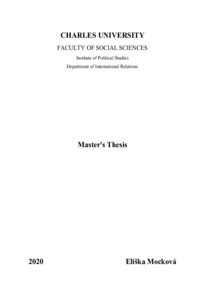Silent Leges Inter Arma? A quantitative study examining compliance with international humanitarian law
Silent Leges Inter Arma? Kvantitativní výzkum dodržování norem mezinárodního humanitárního práva
diploma thesis (DEFENDED)

View/
Permanent link
http://hdl.handle.net/20.500.11956/118660Identifiers
Study Information System: 192339
Collections
- Kvalifikační práce [19618]
Author
Advisor
Referee
Lipovský, Milan
Faculty / Institute
Faculty of Social Sciences
Discipline
International Relations
Department
Department of International Relations
Date of defense
22. 6. 2020
Publisher
Univerzita Karlova, Fakulta sociálních vědLanguage
English
Grade
Excellent
Práce zkoumá používání zakázaných zbraní v nedávných ozbrojených konfliktech (od roku 2014 do začátku roku 2020). Tyto zbraně jsou zakázány souborem mezinárodních pravidel (smluvních a obyčejových) mezinárodního humanitárního práva (MHP). Výzkum se zaměřuje na všechny konflikty, které jsou dodnes aktivní (začátek roku 2020). Tyto konflikty jsou jak mezinárodní, tak mnohem častěji "ne mezinárodní povahy" (konvenčně označované jako vnitrostátní). Diplomová práce mapuje dodržování mezinárodního práva. Ve svém výzkumném záměru jde ale mnohem dále, protože se pokouší identifikovat relevantní faktory, které ovlivňují strany ozbrojeného konfliktu, pokud jde o volbu užít zakázané zbraně, a tedy porušit mezinárodní právo, či nikoliv. Ambiciózním cílem bylo identifikovat nejspolehlivější "substituty" národních donucovacích orgánů v anarchickém světě mezinárodního práva. Práce se tak zaměřila na možné faktory ovlivňující dodržování mezinárodního práva, jako je identita stran konfliktu nebo obavy o pověst. Byl vytvořen vlastní dataset a pro testování hypotéz byl použit model vícenásobné logistické regrese. Mezi hlavní zjištění patří skutečnost, že žádný z faktorů identifikovaných literaturou nebyl schopen spolehlivě předpovědět použití zakázaných zbraní. Navíc ani kombinace všech těchto faktorů nebyla schopna...
The work researches use of prohibited weapons in recent armed conflicts (from 2014 to early 2020). These weapons are prohibited by a set of international rules (treaty and customary) of international humanitarian law (IHL). The research focuses on all the conflicts that are still active to this day (early 2020). These conflicts are both international and more often non-international. The thesis maps the level of compliance, but it goes beyond as it also attempts to identify relevant factors that influence parties to an armed conflict when it comes to the choice to comply or not to comply. The ambitious aim was to identify the most reliable "law-enforcement substitutes" in the anarchical world of international law. It focuses on potential compliance factors such as identity of the parties to the conflict or reputational concerns. Own dataset was created, and a model of multiple logistic regression was utilized to test the hypotheses. The main findings include the fact that none of the factors was able to reliably predict use of prohibited weapons. Moreover, not even the combination of all those factors was able to give a satisfactory picture of the confusing reality on the ground. Other "sideway" findings include a "confirmation" of the popular scholarly belief that compliance with international law...
